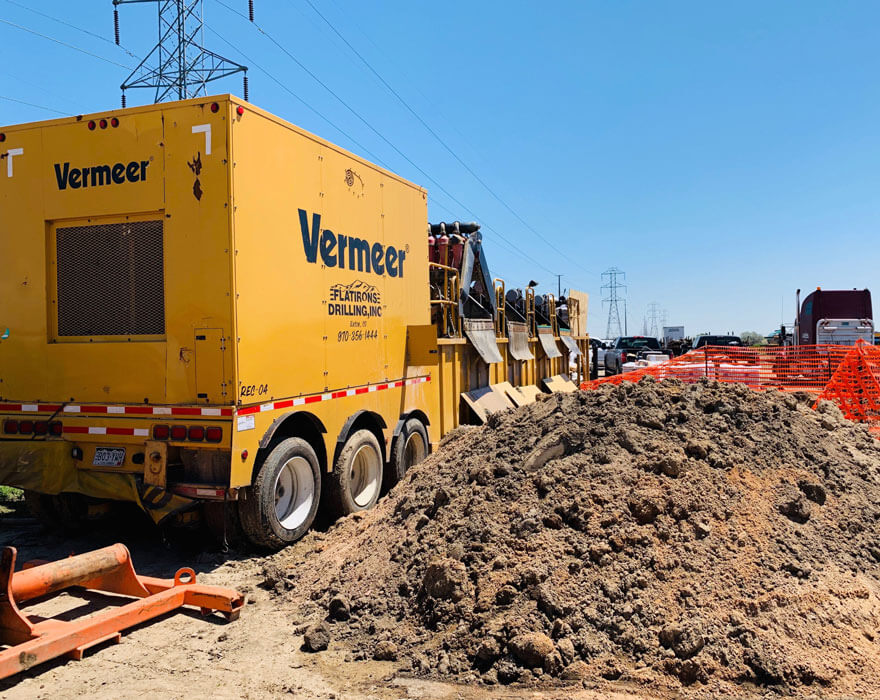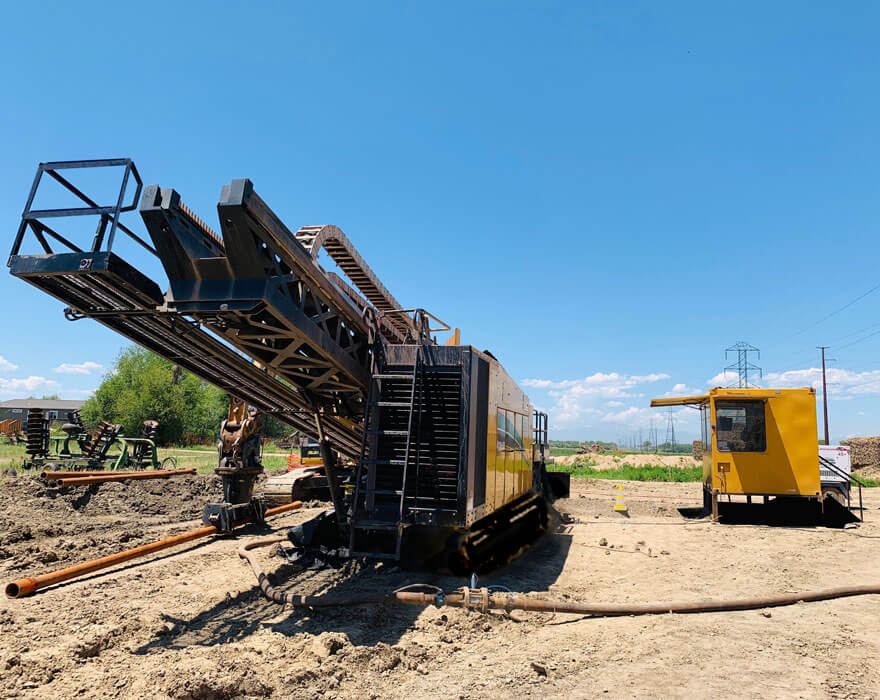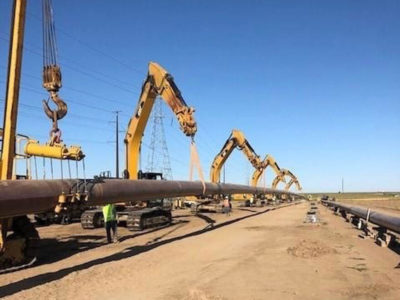Known as the horizontal directional drilling (HDD) contractor willing to take on projects that most contractors choose to pass on, Flatirons Drilling Inc., based in Eaton, Colorado, enjoys a good challenge.
According to Flatirons Drilling’s business development manager, Nickolas Vallie, the 15-year-old HDD company brings a unique skill set to projects deemed impossible by many other contractors. “Our business was started by a small group of skilled HDD individuals who also happened to have a lot of determination,” he said. “That determination is part of Flatirons Drilling’s culture and something everyone on the team brings to work with them every day. From tough ground conditions to unforgiving terrain, we can handle it.”
Having performed long and large-diameter infrastructure work across the country, one of the most challenging states to work in is Flatirons Drilling’s own backyard. Colorado also happens to be where four of its crews recently completed a project for Mears Pipeline and Facilities Group in Weld County.
Project overview
New pipeline transmission lines were run from St. Vrain to the Latham Gas Plant in Platteville — 30 miles (48.3 km) in total. The vast majority of the work was completed using open cut methods by Mears Pipeline and Facilities Group. However, Flatirons Drilling was asked to execute 24 bores, including 16 shots over 2,000 ft (609.6 m). Vallie said HDD was used in environmentally sensitive areas, under roads and railways, and for crossing the South Platte River. Crews installed 24-in, 20-in and 12-in (61-cm, 50.8-cm and 30.5-cm) 500-wall steel pipe, as well as 24-in (61-cm) HDPE production water lines. Bore lengths ranged from 720 ft to 2,700 ft (219.5 m to 823 m).
While most of the area is flat and in rural areas, underground conditions are continually changing. “The thing about working in Colorado is we’re not just dealing with rock,” said Vallie. “What makes the ground here complex is what’s between the surface and the solid rock at deeper depths. It will go through loose soil, sugar sand, groundwater, clay stone, granite and layers of shale before getting into solid rock. A person never knows what to expect.”

Crews used two Vermeer D330x500 HDDs paired with R9x12T reclaimers and SA400 high-pressure mud pumps, and a Vermeer D220x300 S3 HDD paired with a Vermeer R400T reclaimer for bores over 2,000 ft (609.6 m), and a Vermeer D100x140 S3 HDD with an R250C reclaimer to do shorter shots. These machines represent a small share of the maxi rigs the company has in its fleet, which ranges from 60,000 lbs to 500,000 lbs (266.9 kN to 2,193 kN) of thrust/pullback.
In-house capabilities
Many of the project’s shorter shots were done using the Vermeer D100x140 S3 and a conventional locating system. However, the crews performing bores that stretched 2,100 ft, 2,300 ft and 2,700 ft (640 m, 701 m and 823 m) employed wireline locating. “Anytime wirelines are used, a bore requires a larger crew and cycle times increase,” explained Vallie. “For many contractors, there is also the added costs of bringing in outside steer hands to help. We use our own in-house resources to keep us operating as efficiently as possible on projects like this one.”
Flatirons Drilling owns several wireline systems and performs bore profile planning in house. The company engineers that create the profiles then make sure crews are adhering to plans in the field. Vallie said this helps everyone involved with a large-diameter project. “Any pipeline HDD contractor will tell you, a common issue on large-diameter projects is that many bore plans don’t accurately account for rod and pipe bend radius. Crews have to have space to make sure they don’t over stress the pipe being put in the ground. Having an in-house team allows us to get the most from our equipment without overtaxing our tooling and the product being installed.”

Understanding limits
The Flatirons Drilling team knows what each drill in the fleet is capable of achieving, which is critical for overall production and jobsite safety. “We like to say we push our people and machines to go beyond what they think is possible,” Vallie explained. “However, we don’t abuse machines — we push them to their limits, but these drills can handle it. Also, our people are the most important asset we have. We make sure everyone in our work family is doing their job safely so they can make it home to their real families when the job is done.”
One example of how the team gets the most from their machine and people is a 1,250-ft (381-m) bore they did on the project using a Vermeer D100x140 S3. The bore was a 24-in (61-cm) steel pipe, and the ground conditions seemed to change every 20 ft (6.1 m). There was silty sand mixed with heavy glandular gravel and groundwater to start. The bore string then made its way into a denser rock that required the crew to trip out and change tooling a few times before completing the pilot bore. Afterward, the team made a couple of passes with reamers before pulling back the heavy steel pipe.
“We did that bore with a four-person crew and with one of our smaller drills, which is the most efficient way possible,” he added.
Grouting railroad crossings
In addition to the ever-changing ground conditions, Vallie said the railroad also asked the crew to grout the holes underneath train tracks. “We’ve heard about it from other companies, but its something new for us,” he explained.
“There is a growing concern about the long-term effects of the annular space left after reaming large-diameter bores. On this job, we would cut a 36-in (91.4-cm) hole for a 24-in (61-cm) pipe, and they wanted the annular space grouted.”
“Industry partnerships like we have with Vermeer Sales and Service of Colorado are invaluable on projects like this one,” said Vallie. “These organizations’ support gives the confidence to take on the projects that no one else wants to even attempt. They are extended members of our team.”
The right attitude
With a lot of hard work and the right attitude, Flatirons Drilling’s crews completed the 24-bore project in under six months. Each and every one of the shots went smoothly and according to plan. “The customer was happy, our team was happy, and we moved on to the next project to conquer,” said Vallie.
Flatirons Drilling has created a company culture that has helped it grow from a small utility contractor to one of the largest and most reliable pipeline HDD contractors in North America. Its culture is no accident. The company is built by a skilled team that knows how to get the most from its people and machinery.
For more information on Vermeer drills and large-diameter equipment, talk to your local Vermeer dealer today.
This article contains third-party observations, advice or experiences that do not necessarily reflect the opinions of Vermeer Corporation, its affiliates or its dealers. Testimonials and/or endorsements by contractors in specific circumstances may not be representative of normal circumstances experienced by all customers.
Vermeer Corporation reserves the right to make changes in product engineering, design and specifications; add improvements; or discontinue manufacturing or distribution at any time without notice or obligation. Equipment shown is for illustrative purposes only and may display optional accessories or components specific to their global region. Please contact your local Vermeer dealer for more information on machine specifications. Vermeer, the Vermeer logo and Navigator are trademarks of Vermeer Manufacturing Company in the U.S. and/or other countries. © 2020 Vermeer Corporation. All Rights Reserved.
